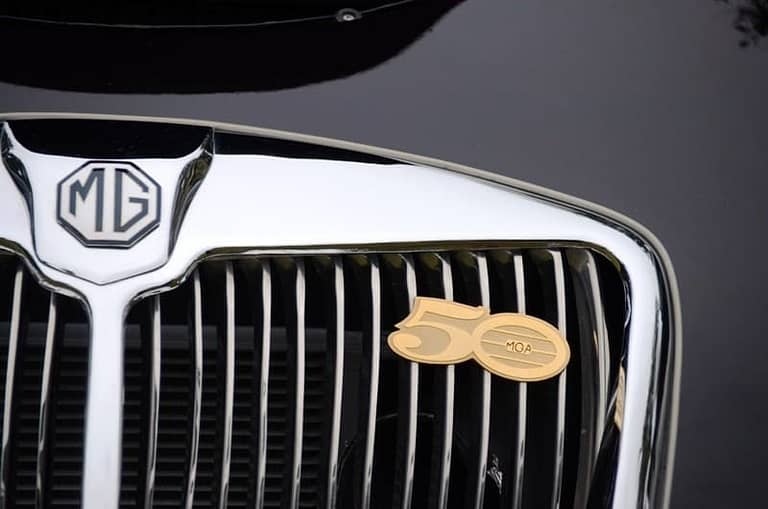
MG Car Club Washington, D.C. Centre Retrospective
 In 1951, the club held its first meeting at Manhattan Auto, the sole MG dealer in the Washington D.C. area, then located at Seventh and R Streets, NW. At that time, the entire East Coast was represented by a single MG Car Club organization, centered in the New York City area. This organization was part of the original MG Car Club founded by Roy Marsh and John Thornley in 1930. This Washington, D.C. area club was founded as a separate sub-centre of the Eastern United States Centre. The number of members involved in the founding is not known, but by 1954, when we became the Washington, D.C. Centre there were 47 members in the club. In 1955, the club won the Nuffield Trophy from our parent MG Car Club as the most outstanding MG Car Club worldwide.
In 1951, the club held its first meeting at Manhattan Auto, the sole MG dealer in the Washington D.C. area, then located at Seventh and R Streets, NW. At that time, the entire East Coast was represented by a single MG Car Club organization, centered in the New York City area. This organization was part of the original MG Car Club founded by Roy Marsh and John Thornley in 1930. This Washington, D.C. area club was founded as a separate sub-centre of the Eastern United States Centre. The number of members involved in the founding is not known, but by 1954, when we became the Washington, D.C. Centre there were 47 members in the club. In 1955, the club won the Nuffield Trophy from our parent MG Car Club as the most outstanding MG Car Club worldwide.
Interviews with several of our club’s earliest members provided invaluable insights into the club’s early activities and adventures. They were different times then. The MG of the day was often an owner’s only vehicle and was used as an everyday car for going to work, shopping, and whatever else was needed. The “whatever else” was quite often a rallye, autocross, gymkhana, or other driving event. Gay Horan, club president in 1956 and owner of a 1952 TD noted, “The wiper motors on the TD were mounted upside down, which caused them to quit working when it rained. It was then necessary to remove the wiper motor from the car and place it in the oven at 250 degrees to dry out.” On one occasion during a state safety inspection Gay engaged the wipers only to find they didn’t work. Without missing a beat she manually operated the wipers successfully throughout the inspection. The inspector asked if this was normal. To which she replied, “It’s an MG, the wipers are manually operated.” No problem passing!
The club’s early interests were heavily oriented toward racing. The Marlboro Speedway in nearby Upper Marlboro, Maryland saw a lot of MG activity in association with the Sports Car Club of America. One member, Tony “Cappy” Capiello, raced his MG there frequently and took corners well enough to have one named after him — Cappy’s Corner. In 1958, the club was instrumental in establishing the Washington Metropolitan Council of Sports Car Clubs to promote more interest and local competition in racing.
Throughout the ’50s, the club was comprised of a small but active and dedicated group of enthusiasts. A well-remembered event occurred when club members showed up in force at National Airport to greet John Thornley, who had come to town to introduce the MGA twin cam to America. This event ended with the members entertaining John in Georgetown for dinner and conversation.
1960 marked the first in a series of yearly rallyes sponsored by the Sports Car Council. The club won the first championship and finished second in 1961. During this time the club’s interests in rallyes, autocross and social events increased and our membership reached a new high of 72 members.
One famous rallye of note, the Fairfax Scramble, was created by Dan Rowzee, club president in 1967. What makes this event notable is that it lasted all night long and participants never left Fairfax County, Virginia, on purpose. Directions were numbered, but were not in numerical order and as a result several cars were not heard from for days.
Perhaps the best rallye the club ever sponsored during this period was the Braille Rallye, first run in 1963 in coordination with the local chapter of Columbia Lighthouse for the Blind. It was established as an incentive for blind children to learn to read Braille. Once the children could read well enough, they were invited to act as navigators for club members driving their MGs. It was extremely popular and soon was expanded to include adults as well as children. The Braille Rallye is one of the club’s most enduring traditions and hasbeen conducted annually since its inception, except for 2020 when like many other events the ongoing coronavirus pandemic and concern over participant health and safety resulted in its cancellation. Each year after the rallye, club members sponsor a picnic for the participants and their families to celebrate the partnership between the club and Columbia Lighthouse for the Blind. Today, this tradition continues to delight and excite many visually impaired children and adults as well as the drivers who participate in the event.

Throughout the ’60s and ’70s, club members remained active in rallyes and social events, but concentrated on driving their cars as much as possible.

